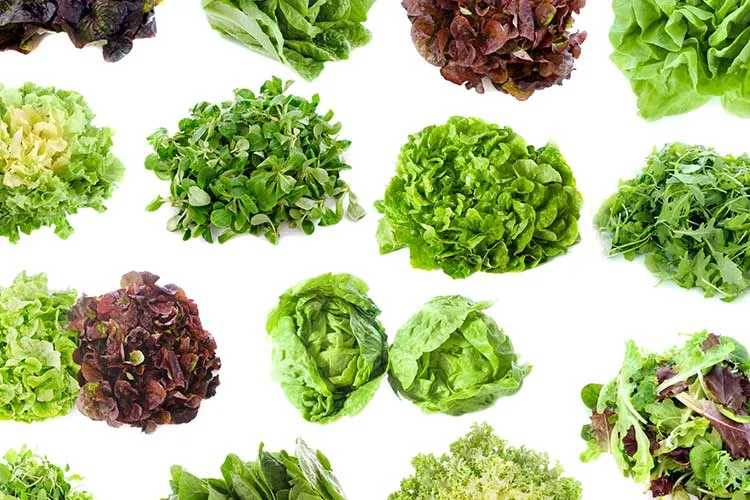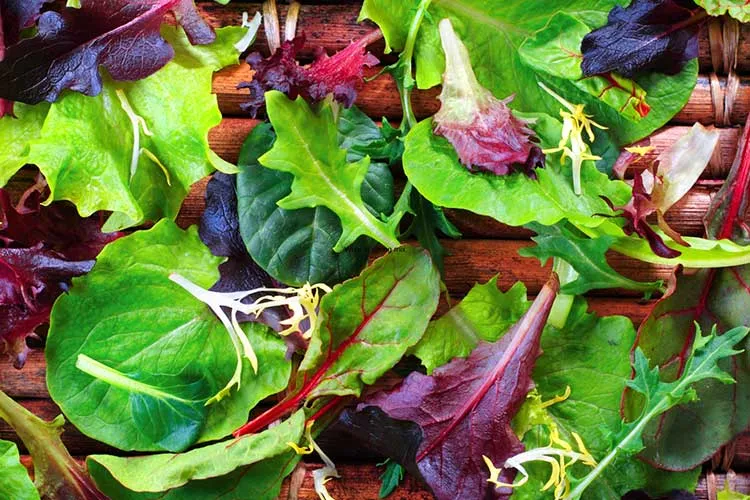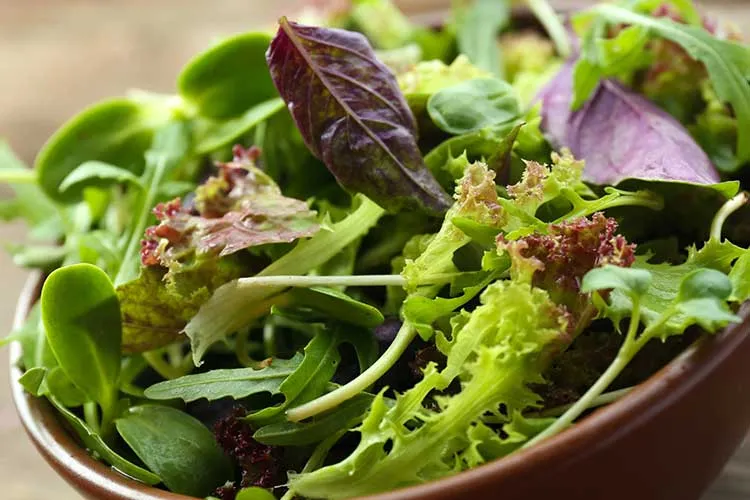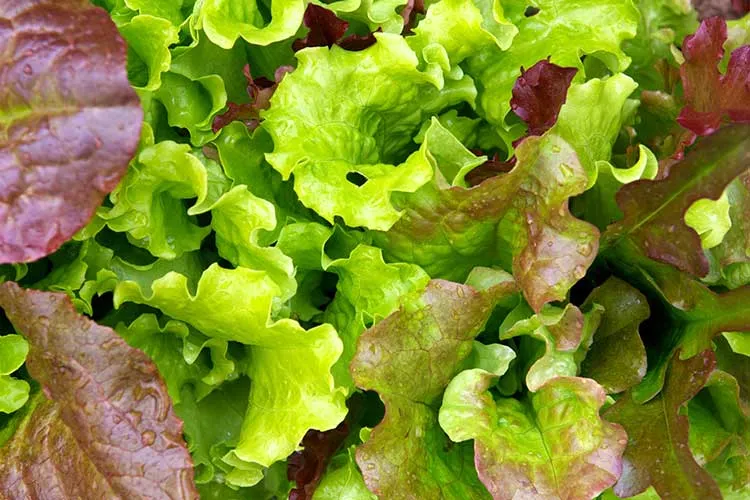Salad greens come in an incredible variety, offering a world of flavors, textures, and colors to explore. From crisp romaine to peppery arugula and delicate mâche, each green brings its unique character to the table. While many leafy greens trace their origins to Europe and Asia, they’ve become beloved staples worldwide, featured in everything from simple side salads to gourmet creations.
Beyond their fresh, leafy appeal, salad greens are versatile and nutrient-rich, perfect for layering with fruits, vegetables, cheeses, and dressings. Whether you’re craving something bold and spicy or soft and buttery, there’s a green to match your taste. Here is a guide to a few of the best salad green varieties we love!
Baby Lettuce
Baby lettuce is a delicate, versatile green that adds a fresh, tender bite to any salad. It consists of young lettuce leaves harvested early in their growth cycle, resulting in small, soft leaves with a mild, slightly sweet flavor. The leaves come in various colors, from vibrant green to deep burgundy, often creating a visually appealing mix in salad bowls.
Baby lettuce is widely available year-round, pre-mixed in bags, and as whole heads at farmers’ markets and grocery stores. Its tenderness makes it ideal for light salads where heavy dressings won’t overwhelm its flavor. Pair baby lettuce with simple vinaigrettes, fresh herbs, and toppings like avocado or goat cheese for a refreshing, restaurant-quality dish.
Because it’s so tender, baby lettuce wilts quickly, so it’s best stored in a dry, cool space and used within a couple of days. Whether crafting an elegant side salad or tossing it into a sandwich for extra freshness, baby lettuce is the perfect starting point for crisp, colorful creations.
Spinach
Spinach is a powerhouse green known for its vibrant dark green leaves and impressive versatility. Its smooth, slightly crinkled appearance adds a lush texture to salads, while its flavor is mild and earthy, with subtle hints of sweetness. Young spinach, or “baby spinach,” tends to be more tender, while mature spinach has thicker, slightly more robust leaves.
Year-round, spinach is easy to find in fresh bunches and convenient pre-washed bags at most grocery stores. This makes it a go-to green for salads, smoothies, and cooking. In salads, spinach pairs beautifully with bold flavors like citrus fruits, nuts, feta, and berries, balancing its earthiness with bright and tangy ingredients.
Spinach also packs a nutritional punch, loaded with vitamins A, C, and K and iron and fiber. Store spinach in a dry, sealed container in the refrigerator to keep it fresh. When using it in salads, opt for a light dressing like lemon vinaigrette to enhance its natural flavor. Whether it’s the star of the bowl or mixed with other greens, spinach adds a wholesome, flavorful touch to any dish.
Arugula
Arugula, often called “rocket,” is a bold and peppery green that brings flavor to any salad. Its tender and slightly jagged leaves have a deep green color that hints at its vibrant, zesty taste. The flavor profile of arugula is unmistakable—spicy, nutty, and a little bit tangy—making it a favorite for those who enjoy greens with a kick.
Arugula is widely available year-round, often sold in bags or bunches alongside other salad greens varieties. Baby arugula, harvested young, is milder and more tender, while mature arugula leaves offer a stronger, more peppery punch. It works beautifully in salads where its distinct flavor can shine, especially when paired with sweeter ingredients like pears, figs, or roasted beets. It also complements creamy toppings such as goat cheese, blue cheese, or avocado.
Besides salads, arugula is incredibly versatile—toss it on pizzas after baking, mix it into pasta dishes, or use it as a sandwich green for added zest. Store arugula in a breathable bag with a dry paper towel to absorb moisture to keep it fresh. With its lively flavor, arugula transforms even the simplest salad into something special.
Red and Green Romaine
Romaine lettuce is a classic salad for its crisp, sturdy leaves and mild, sweet flavor. Red and green romaine varieties share a similar shape—long, upright heads with tightly packed leaves—but differ in color. Green romaine offers a vibrant, bright green hue, while red romaine has a burgundy tint, often concentrated at the leaf tips, adding a beautiful pop of color to salads.
Romaine is widely available year-round and is incredibly versatile. It’s the backbone of Caesar salads, whose crunchy texture perfectly complements creamy dressings and bold toppings. Both red and green romaine can be enjoyed raw in salads, but their robust leaves also make them ideal for grilling or use as a wrap substitute in low-carb dishes.
Mix chopped romaine with juicy tomatoes, cucumbers, and a light vinaigrette for a refreshing salad. Red romaine, in particular, adds visual interest to mixed green salads, combining its subtle bitterness with other greens’ flavors. Store romaine heads whole in the crisper drawer, wrapped in a damp towel to maintain freshness. Whether served as the star or mixed with other greens, romaine delivers crunch and color to any salad bowl.
Red and Green Oak Leaf
Red and green oak leaf lettuce are visually striking greens, named for their soft, lobed leaves that resemble oak tree foliage. The green variety offers a bright, fresh color, while the red oak leaf features deep burgundy tones that bring contrast and beauty to salads. Both varieties are tender and delicate, with a mild, slightly sweet flavor and a subtle buttery texture.
Oak leaf lettuce is available throughout the year and is commonly found in mixed salad greens or whole heads at farmers’ markets and grocery stores. Because of its tender leaves, it’s best suited for raw dishes where heavy dressings or toppings won’t weigh it down. Oak leaf shines when paired with light vinaigrettes, citrus segments, soft cheeses, and nuts, creating fresh and elegant salads.
Oak leaf lettuce is fragile and prone to wilting, so it should be stored carefully. Store it unwashed in a breathable bag in the refrigerator, and use it within a few days for peak freshness. Its mild flavor and beautiful leaves make it a great choice for adding texture and visual appeal to salads, sandwiches, or even as a delicate garnish.
Chard
Chard, often recognized for its colorful stems and large, crinkly leaves, is a striking addition to any salad. There are two main types: Swiss chard, which has white stems, and rainbow chard, which showcases vibrant shades of red, pink, yellow, and orange. The leaves are deep green and slightly glossy, providing beauty and substance in a salad bowl.
Chard’s flavor is earthy and slightly bitter when raw, with a mild sweetness that develops as it’s cooked. While mature chard leaves can be tougher, younger chard (or “baby chard”) is tender and perfect for fresh salads. Pair chard with sweet ingredients like dried fruits, citrus, or honey-based dressings to balance its bold flavor.
Although chard is available year-round, it is most abundant during cooler months. To prepare it for salads, remove the thicker stems (save them for sautés or soups) and slice the leaves into bite-sized pieces. To keep chard fresh, wrap it in a damp paper towel and store it in a breathable bag in the fridge.
Whether you use it as a salad base or mix it with milder greens, chard adds color, texture, and a nutrient boost to any dish—plus, it’s a feast for the eyes.
Endive
Endive is a crisp, elegant green that adds a refined, slightly bitter flavor to salads. Its elongated, tightly packed leaves are pale yellow to light green and have a smooth, sturdy texture that beautifully holds up to dressings and toppings. There are two common types of endive: Belgian endive, with its compact, boat-shaped leaves, and curly endive (also called frisée), which has frilly, delicate edges and a lighter, airy appearance.
Endive’s mild bitterness adds sophistication to salads, especially when paired with sweeter or creamier ingredients. Think crisp apples, juicy pears, candied nuts, or crumbled blue cheese. Belgian endives’ sturdy leaves also make them a popular choice for handheld appetizers, as they act like little edible cups for dips and fillings.
Endive is available year-round, though it’s at its peak during cooler seasons. To store, keep it in a dry, sealed container in the crisper drawer. Avoid washing it until you’re ready to use it, as excess moisture can cause it to wilt.
Whether used as the star of a chic salad or mixed with milder greens, endive’s unique crunch, and flavor make it a favorite for adding contrast and elegance to any dish.
Radicchio
Radicchio is a vibrant, eye-catching green (though technically a member of the chicory family) known for its bold burgundy leaves and crisp white veins. Its compact, cabbage-like head offers a satisfying crunch and a distinct, slightly bitter flavor with a hint of peppery spice. When raw, radicchio’s bitterness adds a welcome contrast to sweet or creamy salad ingredients, while cooking softens its edges and brings out a subtle sweetness.
Radicchio is widely available year-round and thrives in cooler seasons, making it a standout choice for fall and winter salads. Its sturdy leaves hold up beautifully in dishes, whether torn into bite-sized pieces for salads, grilled to mellow its flavor, or roasted to highlight its natural sweetness. Pair radicchio with balsamic vinegar, honey, citrus, walnuts, and creamy cheeses to balance its bitter notes.
To keep radicchio fresh, wrap it in a damp paper towel and store it in the fridge. When preparing, remove the outer leaves, wash gently, and slice as needed.
Whether mixed into a leafy green salad for a pop of color or enjoyed on its own, radicchio adds a sophisticated, slightly bold touch that elevates both the flavor and appearance of your dishes.
Mâche
Mâche, or lamb’s lettuce or corn salad, is a tender, delicate green with small, rounded leaves that grow in petite, rosette-like clusters. Its deep green color and velvety texture make it a visually appealing addition to any salad. Flavor-wise, mâche is mild, slightly sweet, and nutty, offering a soft contrast to sharper, more robust greens like arugula or radicchio.
While mâche was once considered a specialty green, it’s now becoming more widely available, especially in cooler months. You’ll often find it pre-washed and packaged in stores or sold fresh at farmers’ markets. Because its flavor is so subtle, mâche works best with light dressings—think simple vinaigrettes with lemon or olive oil. Pair it with delicate ingredients like roasted beets, citrus slices, or goat cheese for an elegant, balanced salad.
Mâche is more fragile than other greens, so it’s best stored in a dry container and enjoyed quickly. To preserve its delicate leaves, rinse gently and pat dry before using.
Perfect as a salad base or a decorative garnish, mâche brings a refined sweetness to your plate. It is a favorite for those who love soft, buttery greens with a hint of sophistication.
Mustard Greens
Mustard greens are bold, peppery leaves that bring a spicy kick to salads. Their appearance varies, with curly, frilly edges on some varieties and smoother, broad leaves on others. The colors range from bright green to deep, purplish hues, adding visual appeal and a punchy flavor to your greens mix.
Raw mustard greens have a sharp, peppery taste—similar to arugula but with a stronger bite. This makes them perfect for salads that need a little extra zing. Their spiciness balances beautifully when paired with sweet or creamy elements like honey-based dressings, apples, or avocado. Baby mustard greens are milder and more tender, while mature leaves are robust and better suited for cooking.
Mustard greens are abundant in cooler seasons, especially fall and winter, though they’re available year-round in many grocery stores and farmers’ markets. Store unwashed greens in a breathable bag in the fridge with a dry paper towel to keep them fresh.
Mix mustard greens with milder greens like spinach or butter lettuce to tone down their punch for salads. Their peppery flavor shines with bold ingredients like toasted nuts, sharp cheeses, or tangy citrus dressings. Mustard greens add a delicious edge to any dish, whether raw or lightly wilted.
Microgreens
Microgreens are tiny, nutrient-packed greens harvested at the seedling stage, just a few weeks after sprouting. Despite their small size, they come in a variety of colors, shapes, and flavors, depending on the plant—from spicy radish microgreens to sweet pea shoots. Their delicate leaves and thin stems add texture, color, and unexpected flavor to any salad or dish.
Microgreens are widely available year-round and often sold in small containers at grocery stores, farmers’ markets, specialty shops, or online. They’re also easy to grow at home—simply scatter seeds in a shallow tray and harvest once the first true leaves appear. Flavor profiles vary, with some greens offering peppery, earthy, or even sweet notes, making them versatile additions to salads.
While microgreens can be used as a base for a salad, they truly shine as a topping. Sprinkle them over finished salads for a pop of flavor and color, or add them to sandwiches, wraps, and even soups for a gourmet touch.
Because they’re so delicate, microgreens should be stored dry in a breathable container and used within a few days. Microgreens’ vibrant appearance and intense flavors bring style and substance to any dish.




